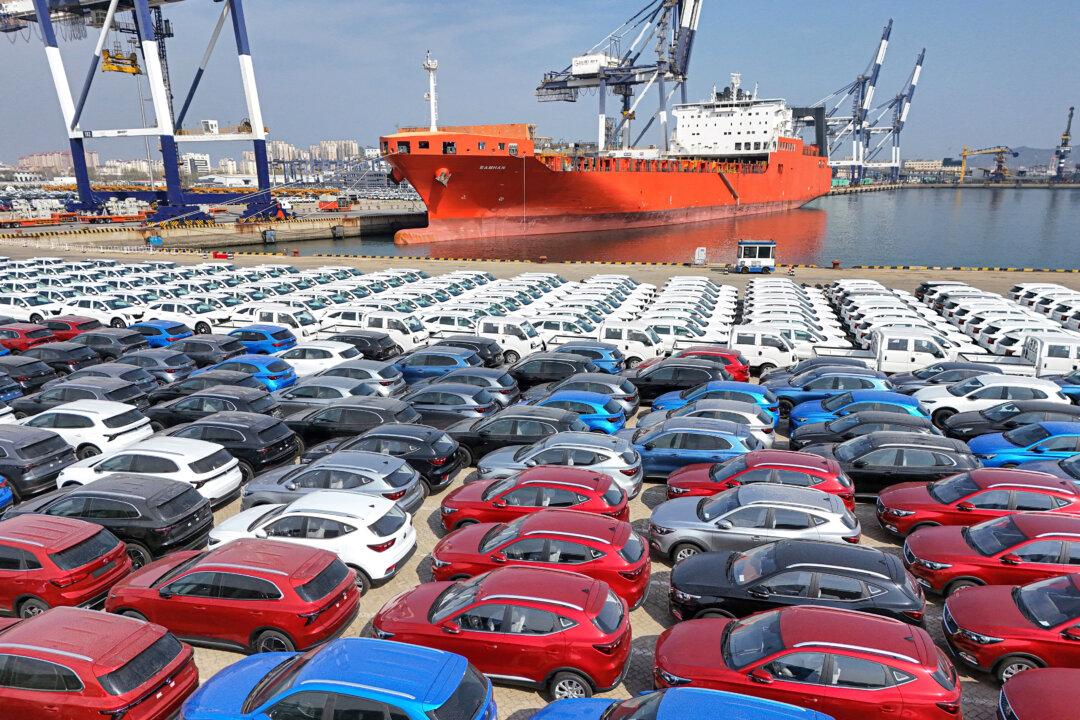U.S. stocks saw a sharp decline on April 3 after President Donald Trump imposed steep tariffs on many nations during a White House Rose Garden address on April 2, marking a new era in U.S. trade policy.
In the weeks leading up to the tariff announcement, markets had already faced significant volatility, with some believing the actual risk was overstated.
Trump said the financial markets will take off once the new levies are in effect.
Briefly speaking to reporters before heading to Florida to participate in a golf event, the president stated that as much as $7 trillion would enter the United States, resulting from investments coming into the country.
“The markets are going to boom,” he said, adding that “the country is going to boom.”
He said other countries “have taken advantage of us for many, many years.”
The Dow Jones Industrial Average, an index of blue-chip stocks, dropped by more than 1,600 points on April 3. The tech-heavy Nasdaq Composite Index dropped by nearly 6 percent, and the broader S&P 500 fell by 4.8 percent.
The Russell 2000, a benchmark average for about 2,000 small-cap stocks, dropped by 6.5 percent. It became the first U.S. stock index to slip into a bear market, down by more than 20 percent from its all-time high close on Nov. 25.
Sectors See Losses
Aside from consumer staples, all major S&P sector indexes dipped on April 3.Energy, technology, and consumer discretionary sectors took the hardest hits, with losses of around 7 percent. Industrials and financials fell by about 5 percent. Materials and real estate tumbled by 4 percent and 3 percent, respectively. The health and utilities sectors dipped by about 1 percent.
“I am scratching my head as everyone else,” Stoyan Panayotov, founder and CEO of California-based Babylon Wealth Management, told The Epoch Times.
“I think the market was very shocked and confused,“ he said. ”The level of tariffs for our trading partners and allies is mind-boggling.”
After flirting with $3,200 earlier in the week, gold also joined the wider market selloff.
Gold prices tumbled from $38.10, or 1.2 percent, to $3.128 per ounce on the COMEX division of the New York Mercantile Exchange. Still, the yellow metal is up more than 18 percent this year and 36 percent over the last 12 months.
The conventional safe-haven asset has immensely benefited from investors seeking shelter amid the market turmoil. Gold prices have also risen on sliding U.S. Treasury yields and a weakening U.S. dollar.
Gold is typically sensitive to interest rate fluctuations because it can influence the opportunity cost of holding non-yielding bullion. A lower greenback, meanwhile, is bullish for gold since it makes it cheaper for foreign investors to purchase.
Meanwhile, oil prices are coming down.
Crude plunged after eight important OPEC+ producers—Algeria, Iraq, Kazakhstan, Kuwait, Oman, Russia, Saudi Arabia, and the United Arab Emirates (UAE)—chose to collectively accelerate output by 411,000 barrels per day, effective in May.
“The gradual increases may be paused or reversed subject to evolving market conditions. This flexibility will allow the group to continue to support oil market stability,” the Organization of the Petroleum Exporting Countries (OPEC) said in a statement.
According to energy market analyst Phil Flynn, once again, markets underestimated Trump and his resolve. However, he noted that Americans will likely benefit from cheaper prices at the gas pump.
“President Trump imposed tariffs on various countries but exempted oil, gas, and refined product imports,” he said in a report. “This exemption reflects his commitment to keep energy prices low for Americans.”
Some analysts suggest that, for those with a long-term perspective, this may be an ideal time to invest in the market.
“If your time horizon is 5, 10, or 20 years, this will be a great buying opportunity,” Panayotov said.
While small caps have been underperforming large caps, Charles LaRosa, an investment analyst at Gabelli Funds, thinks there could be an opportunity to own small-cap stocks, particularly in the current climate.
“Small-cap stocks are poised to benefit from several key trends,” LaRosa said in a note emailed to The Epoch Times.
“Reshoring efforts are bringing manufacturing and supply chains back to [the] U.S., boosting local businesses.”
New Trade Policy
Trump has imposed a 10 percent baseline tariff on all imports, effective April 5. Some trading partners will pay this rate only, including the UK, Singapore, Brazil, Australia, New Zealand, Turkey, Colombia, Argentina, El Salvador, UAE, and Saudi Arabia.Nearly 60 countries listed as “worst offenders” will face higher reciprocal tariffs due to their significant trade barriers, including high tariffs on U.S. goods, non-tariff barriers such as currency manipulation, and value-added taxes (VATs).
These tariffs will take effect on April 9.
The trading partners that made the “worst offenders” list include the European Union (20 percent), China (54 percent), Vietnam (46 percent), Thailand (36 percent), Japan (24 percent), Cambodia (49 percent), South Africa (30 percent), and Taiwan (32 percent).
“Our initial estimates of the reciprocal trade order suggest that the overall U.S. tariff rate could rise into the 25-30% range if the new tariff rates are sustained for a significant period of time—the highest levels since the 1930s,” Deutsche Bank analysts wrote in a note.
Analysts warned that these new measures could reduce economic growth by 1 to 1.5 percentage points this year, significantly increasing the risk of a recession, while also contributing a similar rise to core PCE inflation.
Commerce Secretary Howard Lutnick, in a CNBC interview, said these new tariffs will force other nations to lower their trade barriers against U.S. goods.
“This is the reordering of fair trade,” he said on April 3. “It’s about those non-tariff trade barriers. That’s what we are addressing.”
Global Markets Tank
European and Asian markets reacted similarly.Japan’s Nikkei 225 declined by 990 points, or 2.77 percent. Hong Kong’s Hang Seng Index erased 352 points, or 1.52 percent. The South Korean KOSPI Composite Index slipped by 0.8 percent.
Germany’s DAX declined by 673 points, or 3.01 percent. London’s FTSE shed 133 points, or 1.55 percent. The French CAC 40 Index also fell by 260 points, or 3.31 percent.
While Canada was absent on the list of baseline and higher reciprocal tariffs, the TSX Composite Index dropped by more than 900 points, or about 3.7 percent.
According to Jeff Buchbinder, chief equity strategist at LPL Financial, next week could be a real test for the financial markets as the highest tariff rates take effect on April 9.
“Stocks should stabilize once negotiations start to bear fruit and take rates down, assuming it’s clear to markets that no meaningful tariff rates will be increased further because of retaliation,” Buchbinder said in a note emailed to The Epoch Times.
Following the president’s announcement, Treasury Secretary Scott Bessent appeared on multiple news programs and delivered the same message urging nations not to engage in retaliation.
“My advice to every country right now is do not retaliate. Sit back, take it in, let’s see how it goes, because if you retaliate, there will be escalation. If you don’t retaliate, this is the high-water mark,” Bessent said in an interview with Fox News host Bret Baier.
Tom Essaye, president and founder of Sevens Research Report, does not believe the tariffs will lead to a “bearish gamechanger.”
“This is because administration officials signaled they were open to negotiations and there were various exemptions, including all USMCA-compliant goods, chips from Taiwan, and drugs (pharmaceuticals) from Europe,” he said in a statement emailed to The Epoch Times.
Reactions Mount
The U.S. Chamber of Commerce said in a statement that businesses think these broad tariffs are tax hikes that will raise consumer prices and weigh on economic growth prospects.“We urge policymakers to instead focus efforts on accelerating the pro-growth agenda of extending our current tax policy, re-balancing regulations, and unleashing the full potential of American energy—all policies that will grow the economy and create more opportunities for Americans,” said Neil Bradley, chief policy officer at the U.S. Chamber of Commerce.
Bradley noted that the White House should consider negotiating new trade deals to bolster access for U.S. businesses that “will support more American jobs and lower prices.”
The Business Roundtable agreed with Trump’s efforts to garner better trade agreements that can lower tariffs and expand market access.
“However, universal tariffs ranging from 10-50% run the risk of causing major harm to American manufacturers, workers, families and exporters,” Joshua Bolten, CEO of Business Roundtable, said in a statement.
“Damage to the U.S. economy will increase the longer the tariffs are in place and may be exacerbated by retaliatory measures.”
Ed Yardeni, an economist and the president of Yardeni Research, increased the odds of a recession or stagflation event to 45 percent from 35 percent on March 31.
“Yesterday’s Liberation Day festivities in the Rose Garden set off a freefall in stock prices on increasing fears of a trade war,” Yardeni said in a note.
“The worst-case scenario is a recession if high tariff rates stick, leading to a slowdown in business and consumer spending that causes layoffs.”
Kevin Dempsey, president and CEO of the American Iron and Steel Institute, commended Trump’s initiative to restore fairness and address non-tariff trade barriers.
“Driven by subsidies and other foreign government trade-distorting practices, global overcapacity in the steel industry reached 573 million metric tons in 2024 and has spurred high levels of exports of steel from countries like China, Japan, Korea, Vietnam and Indonesia that continue to produce steel in volumes that significantly exceed their domestic demand,” Dempsey said in a statement to The Epoch Times.








